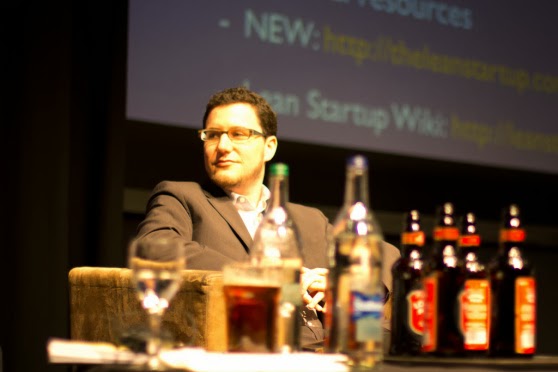Cómo un compositor de películas utiliza Lean Startup
Por Lean Startup Co. Education Program
Recientemente organizamos una conversación por Internet entre Giovanni y Marilyn centrada en cómo las metodologías de Lean Startup se traducen directamente en trabajar en el mundo de la música y la composición.
¿No tienes tiempo para el webcast completo ahora? Vea los puntos destacados y los consejos de su conversación en nuestro blog complementario a continuación.
Si desea leer la transcripción completa de la conversación de Marilyn Gorman con Giovanni Rotondo, puede descargarla.
Encontrar conexiones Lean Startup en mundos no emergentes
Como compositor de cine y televisión, Giovanni Rotondo no está en una línea de trabajo tradicionalmente asociada con nuevas empresas o iniciativas Lean Startup. Todo empezó a cambiar cuando se unió a una startup en Londres llamada The Rattle."[The Rattle] es [tanto] una incubadora de carrera para artistas como una incubadora de startups para startups musicales", explica Giovanni. Inicialmente, se unió como artista, pero Giovanni estaba intrigado e inspirado por la cultura de startups y comenzó a tener ideas propias que se aplicaban al mundo de la música. Compartió su idea con el copropietario y cofundador de The Rattle, Chris Howard. Chris sugirió el libro The Lean Startup a Giovanni. Mientras lo leía, Giovanni podía sentir la conexión entre el mundo de las startups y su ocupación.
"Realmente [me zambullí] en mi mente para ver cómo aplicar estos conceptos a mi trabajo", dice Giovanni, "y ... encontré varias maneras".
"Realmente me sumergí en mi mente para ver cómo aplicar estos conceptos a mi trabajo, y encontré varias maneras".
La señal mínima viable
En su sitio web, Film Scoring Tips, Giovanni escribió una serie de blogs de tres partes llamada "The Lean Composer" (blogs, aquí, aquí y aquí). En estos blogs, explora las principales conclusiones que los artistas compositores pueden quitar de la metodología The Lean Startup.La primera y más sorprendente idea que se conectó con Giovanni fue la de un producto mínimo viable. Pero, al aplicarlo a su mundo, lo llama "señales mínimas viables".
En el mundo de la composición cinematográfica, una pieza musical que tiene un principio y un final se denomina cue. Mientras trabajan en un proyecto de puntuación, los compositores deben enviar lotes iniciales de señales a un director. Esto puede ser una tarea desalentadora y lenta. "Una primera tanda de claves exitosa puede significar una experiencia de escritura global exitosa", explica Giovanni. Así que un primer lote de señales problemático puede ser un desastre.
Giovanni se dio cuenta de que podía hacer que esta fase en el proceso fuera más eficiente enviando la señal antes del proceso. Lo hace logrando que la música llegue al punto en que suena bien y transmite la idea, pero aún no está completamente refinada. "[Los directores] no tienen que saber que no es perfecto", señala Giovanni, pero aún así, "debe sonar perfecto para ellos". El refinamiento puede venir más adelante en el proceso.

La psicología involuntaria de las pruebas A / B
Otra metodología de Lean Startup que Giovanni ha implementado con éxito en su trabajo como compositor es la idea de las pruebas A / B."He comenzado a enviar los primeros lotes de señales en las versiones A / B", explica. Esto le permite probar el trabajo en los directores para ver qué versiones funcionan mejor. Además, él cree que hay un componente psicológico involucrado. Al enviar opciones, en lugar de solo una iteración, puede hacer que el receptor sienta que tiene que elegir qué opción es la mejor, en lugar de simplemente aceptar o rechazar el producto enviado. "Es casi como si eliminaras la negativa de la ecuación".
E incluso si una de las versiones no es aceptada, es una buena manera de descartar áreas para no tocar o resaltar una dirección que sea buena.
"He comenzado a enviar los primeros lotes de señales en las versiones A / B".
Haga clic para twittear
Encontrar el orgullo en tu pivote
Pero incluso con la búsqueda de formas de maximizar el tiempo y el éxito, en una industria creativa, el fracaso es una gran parte del viaje. "[...] Muchas veces ni siquiera es culpa de una persona en particular", dice Giovanni, "son solo dos artistas que tratan de encontrar un terreno común".Eso hace que sea aún más importante aprender a aceptar, aprender y seguir adelante con el fracaso. "Mi corazón aún se rompe cada vez [se rechaza una señal]", dice Giovanni, "[así que] es una cuestión de qué tan rápido puedes recuperarte de él".
Una de las maneras de lidiar con el fracaso es encontrar formas de pivotar. Pero al girar, aún debe tratar de sentirse tan orgulloso de su nuevo producto como lo estaba con el concepto original. Es una cuestión de ajuste. Cuando giraba sobre una pista, Giovanni conservaba algunos de los elementos que creía que estaban funcionando. Le ayudó a sentir que no había perdido el tiempo y que estaba adelantado a tiempo.
Para Giovanni, esta capacidad para girar y aún producir un trabajo excelente "me hace sentir que ahora tengo superpoderes".

Salga de su caja
En el futuro, Giovanni quiere seguir aplicando las metodologías de Lean Startup en su trabajo y en la comunidad musical. Quiere que su blog sea un lugar para presentar métodos nuevos y actualizados para los compositores de películas."Para mí, la mejor parte de la adopción de este nuevo conjunto de [...] reglas es que elimina el estrés de la experiencia. Y mientras más divertido lo hagas, mejor lo harás ".
Giovanni también subraya la importancia de exponerse a culturas e influencias externas, como leer libros que están fuera de su campo o ver películas que son géneros que no le gustan. Es importante no solo cerrarse en su área de especialidad. "Hay algo que aprender en estas experiencias", dice.






 5:59
5:59
 Juan MC Larrosa
Juan MC Larrosa









.png)















